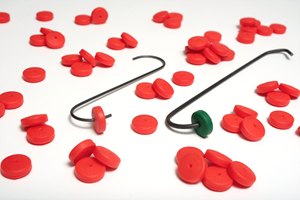Racks for Powder Coating
Powder coating consultant and PF columnist Rodger Talbert discusses the importance of good racking methods for your powder coating operation.

Rodger Talbert has more than 30 years of experience in the powder coating industry.
Q: We installed a new powder system 4 years ago and we like the process a lot. Our product quality has improved and we have control over the coating process. We can do a good job most days and get out a lot of good parts but we are not as consistent as we want to be in terms of coverage and productivity. We get more light coating and heavy coating than we want some days, we have trouble keeping up with the loads coming from fabrication.
One of my concerns is the way we rack our parts and take care of our hooks and racking. Our racking does not seem to take complete advantage of the available line time or space in the spray zone. Some of our racks have a lot of powder build-up on the contacts and rack maintenance is not always perfect. It seems like we are not really getting the best results with our line density and there are often gaps in production. Is there any way to qualify the impact of racking on the powder coating process? What would you recommend as the best options for racking a variety of large and small parts?
A: This is an issue that comes up from time to time and I am always glad to answer. One of the most common areas of waste in a powder system is poor racking concepts. Good racking schemes hold the part steady, hold the part consistently, provide good ground at all times and maximize available line space and spray gun capacity. It is very common to see line gaps that should not be there, bent and broken racks, twisted hooks, too much powder build-up on racks, racks that are only partially full, different hooks or racks being used for the same part or just bad rack designs. The cost of poor racking is more rejects, more wasted powder and excessive lost revenue.
Hooks make good sense for some parts that have available holes and can be hung in a steady position. Pinch clips can be good for some parts to maximize space and position a part for simple access to the entire surface. What to use depends on the volume of parts that are going to be racked over time and the simplest and easiest way to hold the part correctly with good density. Poor racking is easy to spot — lots of excess space around parts, inconsistent position and areas that are hard to see or cover. Good racking is steady, has proper spacing between parts and provides the best possible access to all surfaces.
Good racking is sometimes more costly than simple hooks or utility racking but it can also provide great results that actually reduce production cost and improve first-pass yield.
Cost can be evaluated to determine the difference between a good racking arrangement and a poor racking arrangement.
The principles to keep in mind for racking design are listed here:
- Good density is an important key. Parts should be grouped close enough together to reduce the space around them so the ratio of metal to air is high. There is a limit to density; there must be enough space around a part to make it easy to cover. But within reason, more is better.
- Parts should be positioned so that they can be easily accessed and easy to see.
- Parts should be held in a stable and consistent position.
- There should not be large gaps between racks as long as there is sufficient time to coat the parts based on the line speed and number of guns.
- Contacts must always be clean so that there is no way a part can be insulated from earth ground by coating build-up.
To determine the cost associated with the racking, a coating operation can evaluate what the throughput is with a good rack that follows the listed principles and compare it to a simple hook that may or may not provide good throughput. Samples can be built to test theories and compare the defect rates to any other rack method. It is simple math to evaluate the number of parts per foot and the number of good parts versus bad parts. Many companies waste a lot of dollars by using sub-optimum racks because they do not want to invest in tooling, they do not want too many different rack designs around or they just do not even evaluate it at all. Evaluate the options and there is a good chance you can improve the throughput and reduce costs by using the right racking scheme.
Consider a rack that holds one part on a simple hook. You know you can hold four parts if you build a special tool. The better tooling will cost around $800 for a full set of four-piece racks. By dividing the fixed cost (the cost of operation or overhead that is the same no matter how many parts are coated) by the production throughput you can determine the savings associated with four parts in the same space as one. The ROI (return on investment) can be a large number, especially if the volume of the part is high and the runs are frequent. If the volume is low and the parts are not run frequently the ROI may be too slow to justify the expense of the new tooling.
Good racking can improve your first pass yield and get more parts through the system, making the ROI very fast. Always evaluate options and choose the smartest racking method, even when it means investing in a new tool.
Related Content
Chicago-Based Anodizer Doubles Capacity, Enhancing Technology
Chicago Anodizing Company recently completed a major renovation, increasing its capacity for hardcoat anodizing and Type II anodizing.
Read MoreFABTECH 2024 Heads to Orlando
CCAI’s FINISHING Pavilion and Conference continues to grow at FABTECH, offering insights and innovations covering all aspects of industrial surface finishing.
Read MoreTroubleshooting 5 Common Racking Problems for Platers
Being aware of usual issues that might occur during the plating process will prepare platers by helping them know how to avoid them all together or how to fix them if they happen.
Read MoreCFS Unveils New Hook Locks Parts Racking Solution
New product from Custom Fabricating & Supplies (CFS) prevents part loss during coating processes.
Read MoreRead Next
On Thermoplastic Powder Coatings
Tim Brinner of IFS Coatings explains the difference between thermoplastic and thermosetting powder coatings, and discusses applications where thermoplastic powders can be used to greatest effect.
Read MoreUnderstanding Infrared Line-of-Sight
Marty Sawyer of Trimac Industrial Systems offers insights into using infrared to accelerate your powder coating curing operations.
Read MoreOutgassing and Powder Coating Defects
Having trouble with bubbles forming during curing? Verney Denerville of TIGER Drylac discusses proper outgassing procedures.
Read More






















